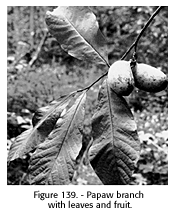PAPAW OR PAWPAW
Asimina triloba (L.) Dunal, family AnnonaceaeThe papaw, not to be confused with the papaya, is native from New York to the Gulf of Mexico and west to Wisconsin and Texas (Gould 1939). It is rarely cultivated other than as a dooryard planting, but it (Anonymous 1969) is just awaiting final development. Its fruit is most prized of the native species of Annonaceae. It belongs to the same family as the cherimoya and related custard apples and produces a similar, delicious, many-seeded fruit.
Plant:
The papaw is a small, shrubby, deciduous tree, 15 to 20 feet tall, with straight upright branches forming a rounded crown. The oblong, glossy leaves are 6 to 12 inches long. The plants usually occur in thickets of many specimens in a small area. The greenish to yellow, banana-shaped fruit is 3 to 7 inches thick and turns brown when ripe (fig. 139). It ripens in the fall. The seeds are about an inch long, flat, blackish brown, and imbedded in the soft, edible pulp (Walden 1963). From l/2 to 1 bushel of fruit may be harvested from one tree.
[gfx] FIGURE 139. - Papaw branch with leaves and fruit
Inflorescence:
The chocolate, dark-purple, or maroon-colored flowers are about 2 inches across. They occur on last year's growth, solitary or in small clusters. They are protogynous, the three to 15 stigmas becoming receptive about 24 hours before the pollen is shed from the surrounding anthers borne on short fleshy filaments. The short styles lead to the numerous ovules to produce the large compressed seed (Ochse et al. 1961*). There are six petals, the three inner ones small and erect, the larger ones forming a corolla similar to a tulip blossom.
Pollination Requirements:
The stigma, being receptive before the anthers dehisce their pollen, requires pollen from another flower. Selfing is impossible (Ochse et al. 1961*).
Pollinators:

Evidence has shown that pollination is accomplished by insects especially honey bees bringing pollen from older flowers. Knuth (1908*, p. 54) stated that "In the first (female) stage of anthesis the three inner petals lie so close to the stamens that insect visitors (flies) cannot suck the nectar secreted at the bases of the former without touching the already mature stigmas. In the second (male) stage the stigmas have dried up and the inner petals have raised themselves so that the anthers - now covered with pollen - are touched by insects on their way to the nectar. Cross-pollination of the younger flowers is therefore effected by transference from the older ones."
Pollination Recommendations and Practices:
None.
LITERATURE CITED:
ANONYMOUS.
1969. CALIFORNIA RARE FRUIT GROWERS NEWSLETTER. 1(1): 1-4.GOULD H. P.
1939. THE NATIVE PAPAW. U.S. Dept. Agr. Leaflet 179, 6 pp.WALDEN F.
1963. A DICTIONARY OF TREES. 80 pp. Great Outdoor Publishing Co., St. Petersburg, Fla.
